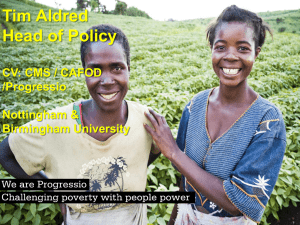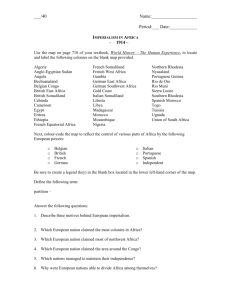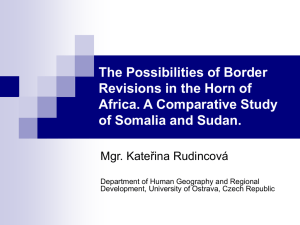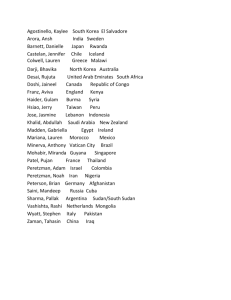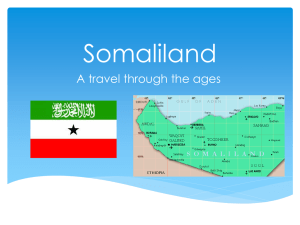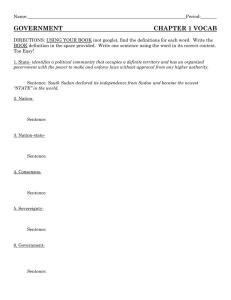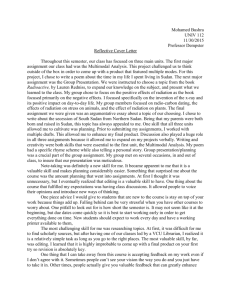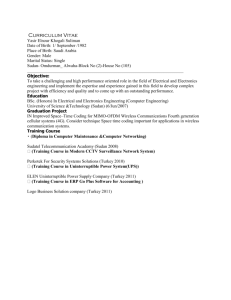State Secession: Who Decides?
advertisement
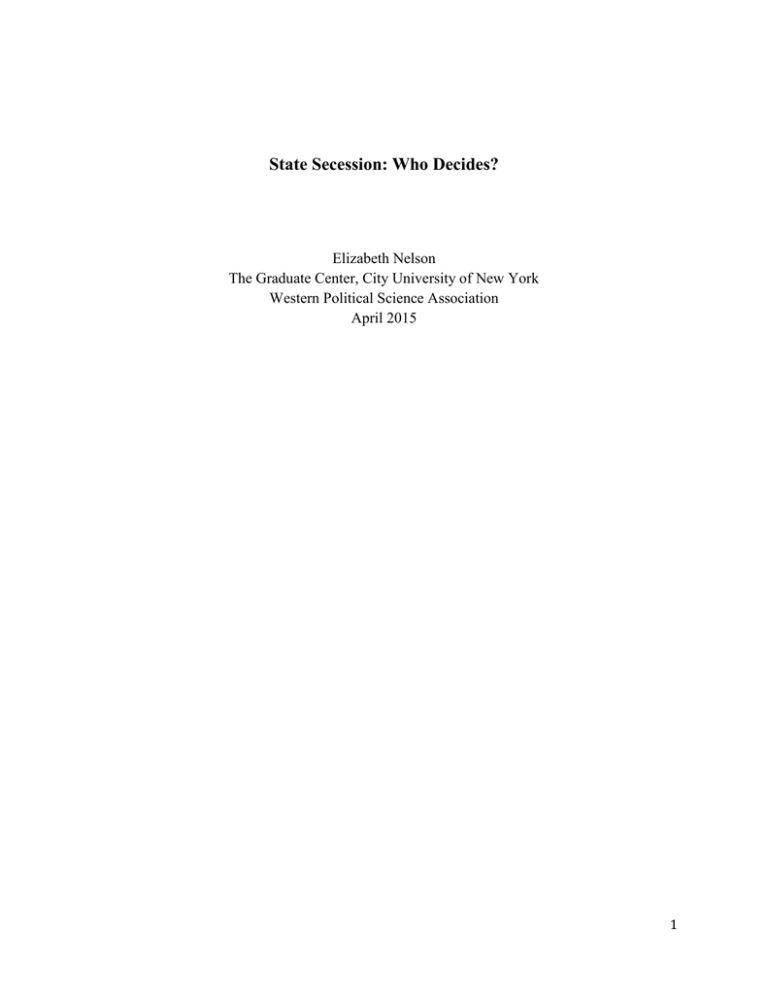
State Secession: Who Decides? Elizabeth Nelson The Graduate Center, City University of New York Western Political Science Association April 2015 1 “If there is one constant in history apart from the certainty of death and taxes, it is the reluctance of states to part with territory.” M. Hechter. Introduction and Theoretical Framework State sovereignty and its corollary, territorial integrity, form one of the foundational norms of the international system. Its significance is demonstrated by its articulation as a core principle in the United Nations Charter as well as the founding documents of most regional political organizations, including the African Union, the European Union, and the Arab League, among others. State secession violates territorial integrity in the most fundamental way, and perhaps, not surprisingly, is a rare occurrence. While most secessionist movements fail, some exceptional movements succeed in achieving statehood. It is not immediately clear why these particular movements should achieve statehood. Some of these newly created states look far less like states than many that have not achieved recognition. While any definition of a state is subject to debate, the criteria listed for statehood in the Montevideo Convention on the Rights and Duties of States (1933) are commonly accepted in international law and international relations. These include: a defined territory; a permanent population; a functioning government; and the ability to enter into foreign relations. Somaliland has had a functioning government for over twenty years; it has free and fair elections, its own currency and flag, and even conducts limited foreign policy. Yet, despite its declaration of independence in 1991, the international community refuses to recognize it. South Sudan, on the other hand, emerged from Africa’s longest running civil war in 2005 as one of the least developed areas on the continent, with no history of self-governance, and no formal institutions. Yet as of January 2011, South Sudan was recognized by the world as the newest state in the international system, and was quickly granted membership into the United Nations. 2 So what accounts for the success of South Sudan and failure of Somaliland? This question has become increasingly important given the spike in secessionist movements since the end of the Cold War. It is clear that each secession is unique: the context within which it arises includes a very particular set of personalities, institutions, culture, and history. However, there are some factors that are generalizable across secessions, the most important of which is the crucial role of external actors. While domestic factors can help explain the path to de facto statehood, which may include a functioning regional government with a certain degree of autonomy, there is no inevitable link between de facto and de jure statehood. De jure statehood is not possible without external recognition, so the significance of the international community at large is clear. The most powerful states in the international system tend to be the most influential, and it follows that the great powers should play an important role in whether a new state is recognized as such (Coggins 2014, Sterio 2013). However, while power is a useful explanatory tool, I argue that proximity is key. Through an analysis of the secession of South Sudan and the attempted secession of Somaliland, I hope to contribute to the existing literature by emphasizing the role that regional actors play in successful secessions, an area that has been largely neglected. There is usually a relationship between proximity and interest. Regional actors’ interests are more likely to be affected by developments within their region than far away powers. Regional actors are, therefore, more likely to have a stronger interest in the outcome, and more incentive to take greater measures to effect a desirable outcome. There are three mechanisms through which regional actors can affect the outcome of a secession. First, they can provide tangible support to the physical survival of a movement. Their proximity to the secessionist movement allows for more direct interference, which, particularly for contiguous states, can 3 facilitate clandestine support. Not only can they provide military or economic support, but they can also provide sanctuaries when it is too dangerous for groups to operate from within their home state. Second, they can shape the diplomatic landscape as they are often uniquely positioned to initiate negotiation processes between the parties and can act as gatekeepers between a secessionist movement and the great power(s), facilitating great power support, or obstructing it. They can provide a movement with legitimacy to the wider international community, and, to the parties in conflict, they can frame international involvement in desirable or undesirable terms. Finally, to the extent that any of the great powers have an interest in the outcome, they will take regional actors into consideration when determining foreign policy. These considerations may include issues relating to regional stability or a great power’s existing relationships in the region. While the body of literature on secession is vast, few scholars address the likelihood of a movement’s success in terms of achieving statehood. Of those that do, none look to the role of actors in the region. If my argument is correct, international law on statehood, territorial integrity and self-determination have little to do with the success of a movement. Further, factors endogenous to a secessionist movement are significant in terms of its success only to the extent that those factors affect regional states’ relationships with the movement.1 Lastly, understanding the preferences of regional actors is necessary to inform great power involvement in the secession, thus contributing to existing theories that rely on great powers to explain successful secessions. Many secessionist struggles are deadly, protracted civil wars. For those involved in negotiating peace, it is critical to know which actors must buy into the process in order for it to 1 For example, the liberation movement in South Sudan adopted a Marxist ideology in the early 1980s, which appealed to the Marxist regime in Ethiopia, and led to more Ethiopian support for the movement. 4 have any longevity. In the longer term, in an effort to avoid some of these secessionist wars, some kind of framework for secession needs to be developed. To create a framework that has a chance of success, it is crucial to understand why secessions happen when they do, and who plays the most important role in determining that outcome. This research suggests that efforts should begin with institutions at the regional, rather than national or global levels. Most empirical studies on secession focus on the causes and dynamics of secessionist wars, rather than their results. International legal scholars who focus on secession tend to ask whether there is a right to secession under international law. Contrary to these scholars, I focus primarily on the relationships between states to explain outcomes. My research builds on the work of two scholars who look to the politics of external actors to explain why some secessionist movements achieve statehood. Both Sterio (2013) and Coggins (2014) argue that great powers determine secessionist outcomes. I also emphasize the importance of the role that external actors play in secessions, though I argue that regional actors play the most important role. Regional actors have more connections with the home state and the secessionist movement, and are, to a large extent, gatekeepers between the great powers and the secessionist struggle. In the literature on secession, some scholars suggest that whether a movement succeeds or fails will be determined by domestic factors. The military strength of a movement increases its ability to establish domestic authority within an area, resulting in de facto statehood. One of the ways to increase military strength is to induce defections from the home state’s military forces. To that end, Horowitz (1985) looks to the ethnic composition of the military and the movement to explain when defections are more likely. Thus, the ethnic composition of the military can affect the likelihood of a group achieving de facto statehood. Crawford (2000) suggests that de facto statehood cannot be ignored, and will therefore result in de jure statehood. 5 Other scholars look at how domestic institutions can affect the success of particular groups. Secessionist movements are more likely to find success in federal systems where ethnic groups are concentrated, than ethnically dispersed unitary systems (Roeder 2007). Ethnic concentration can facilitate mobilization and strengthen self-determination arguments. While the granting of some autonomy may appease some movements, those that are committed to independence will benefit from the self-governing structure a federation offers (Roeder 2007, Bunce 2004, McGarry & O’Leary 2003). Horowitz (1985) and Herbst (1989) look at how concerns over a demonstration effect can increase the motivation of a state to crush a movement. The demonstration effect refers to the inspiration that a successful secession can provide to other movements. If a state is made up of a number of different ethnic groups, the demonstration effect may cause a number of other groups within the state to seek statehood. This logic suggests that a demonstration effect is less consequential in a state with few ethnic groups; the groups that would be inspired to secede simply do not exist. Therefore, secession is more likely to succeed in states with fewer ethnic groups. A state may be less determined to crush a movement if the consequences of the movement’s success are not so far-reaching. While each of these domestic factors may be helpful to a movement, alone they cannot account for the variation that exists in terms of successful secessions. Somaliland has certainly achieved de facto statehood and yet the international community has been quite capable of ignoring it. De facto statehood in this case has not inevitably led to de jure statehood. While ethnically concentrated federal states can certainly empower secessionist movements, this explanation does not explain why movements like those in Biafra in Nigeria, or Katanga in the Democratic Republic of Congo, have failed. Likewise, concern over the demonstration effect 6 cannot account for successful secessions in states with multiple ethnic groups, e.g. in Bangladesh’s secession from Pakistan. Legal scholars have written extensively on statehood and the right to secede, explaining if and when such a right should exist. Most legal arguments for the right to secession are based on the right to self-determination, which refers to the right of a people to freely determine their political status and pursue their economic, social and cultural development.2 While expressing the right to self-determination through secession became widely accepted in the context of decolonization, outside of that context, the meaning of self-determination has become more fluid.3 Today the relationship between self-determination and secession is not clear, though the international norms of state sovereignty and territorial integrity have caused most states to view secession with suspicion. There is a distinction between internal self-determination, referring to the protection of a people within a state through some level of autonomy and self-government, and external selfdetermination, referring to self-determination expressed through secession. To the extent that a right to self-determination through secession is said to exist, it is a right to what is known as “remedial secession,” meaning that the right exists only to overcome an ongoing injustice (Buchanan 1997, Birtch 1984, Borgen 2007). The home state must be violating the human rights of the group seeking secession for this remedial right to exist. However, there is no consensus on the right to external self-determination, as a number of prominent international lawyers deny its existence (Crawford 2000; Wildhaber 1995). 2 International Covenants on Civil and Political Rights, and Economic, Social and Cultural Rights, Art. 1. The UN Charter provides that it is to develop friendly relations among nations based on respect for the principle of equal rights and self-determination of peoples (Art. 2). 3 Given the fact that territorial borders for the most part remained the same during decolonization, many question whether these should really be considered “secessions” at all. 7 In this research I study the influence that regional actors have on state secession. I hope to demonstrate that regional actor support is the most important factor in successful secessions. I define successful secession as internationally recognized statehood, the clearest demonstration of which is membership into the United Nations (UN). Although UN membership is discrete, states may be recognized by less than all states, or they may be only temporarily recognized. I have selected case studies on the independent (causal) variable, regional support. My cases are South Sudan and Somaliland. In South Sudan, there was a large degree of regional involvement and ultimate support for the secession. In Somaliland, however, there was little support for the secession, and in fact opposition among many of the regional actors. Cases: South Sudan and Somaliland The secession of South Sudan and the attempted secession of Somaliland have a number of similarities, and some of the ways in which they differ may suggest an alternative outcome, i.e. that Somaliland would achieve international recognition. I will provide a brief historical overview of the path to South Sudan’s de jure statehood and Somaliland’s de facto statehood before assessing their legal justifications for statehood. I will then focus primarily on distinguishing between the role regional actors played in each case. South Sudan is one of the rare examples of a successful secession. It emerged as the newest state in the international system on July 9, 2011. In a referendum on secession in January of that year, over 95% of voters chose to secede.4 While Sudanese President Omar al Bashir ultimately agreed to the referendum, the fact that Sudan had been in a state of civil war involving separatist movements for almost 40 of the 50 preceding years demonstrates that this was no easy consensus on separation. Somaliland, on the other hand, declared independence in the midst of 4 The referendum on independence had been written into the Comprehensive Peace Agreement (2005), which had ended Sudan’s civil war. 8 Somalia’s civil war in May 1991, and over twenty years later, has yet to be recognized as independent by any state. I. Historical Overview There are a number of similarities between South Sudan and Somaliland in terms of the context in which separatist sentiment emerged. Great Britain had colonized both Sudan and Somaliland. Through what was known as the “Southern Policy,” Great Britain treated North and South Sudan as separate entities. Although Sudan ultimately emerged from colonialism as one country in 1956, there had been questions leading up to independence as to whether that should be the case. Somaliland gained its independence from Great Britain in 1960, five days before it decided, in the spirit of pan-Somalism, to join in a union with former colony, Italian Somaliland, to form Somalia. Very soon after independence, it became clear to both South Sudan and Somaliland that they were politically excluded and marginalized. Southerners in Sudan did not have a proportional role in the political, administrative, or military systems. Likewise in Somalia, power was concentrated in the South, away from Somaliland. Only four of fourteen ministers came from Somaliland, none of whom held positions in the key ministries of foreign affairs, the interior, and finance. What follows is a brief historical overview of the secession of South Sudan and the attempted secession of Somaliland. South Sudan A civil war broke out in Sudan in 1955 between rebel forces known as the Anyanya in the South and the central government in the North. Anyanya’s goal was the secession of South Sudan, which it defined as an act of liberation from colonial rule and foreign domination 9 (Metelits 2004, 69). The war ended in 1972 with the Addis Ababa Peace Agreement, which provided a number of accommodations to the South, all short of independence. Over time, it became clear that the central government was not complying with commitments made in the agreement, and the autonomy promised to the South was more rhetoric than reality. Sudan relapsed into civil war in 1983, this time the newly formed rebel group the Sudan People’s Liberation Movement/Army (SPLM/A) fought against the North. Although the SPLM/A initially articulated its goal as a new, united Sudan, there was always some secessionist sentiment within the movement. A regional organization first known as the Inter-Governmental Authority on Drought and Development (IGADD) first attempted unsuccessfully to negotiate a peace between the parties in 1993.5 The process was reignited in 2001, and a ceasefire was declared in 2002 in the Machakos Protocol, which formed the basis for the Comprehensive Peace Agreement (CPA). The CPA was signed in 2005 after continuous involvement and pressure from IGAD and pressure from actors outside of the region, namely the United Nations and the United States. The CPA provided for a referendum on South Sudan’s independence to be held within six years. During these six years the central government failed to keep its commitments under the CPA, and in the referendum held in 2011, the population in the South voted overwhelmingly in favor of independence. Somaliland Somalia held its last democratic elections in 1967. In 1969, a military coup brought General Said Barre to power. In 1977, Siad Barre invaded Ethiopia to “liberate” the Somalis of the Ogaden region, and was defeated in 1978. Approximately one million ethnic Somalis fled 5 IGADD had been a sub-regional organization established in 1986 with a narrow mandate around issues of drought and desertification. Beginning in the 1990s, it became an accepted vehicle for regional security and political dialogue. Its Standing Committee on Peace in Sudan included: Kenya, Uganda, Ethiopia and Eritrea. A restructuring in 1996 changed its name to the Inter-Governmental Authority on Development (IGAD). 10 Ethiopia and entered Somalia. The arrival of the refugees put pressure on limited natural resources and services. Existing resentment in Somaliland against the Mogadishu government in the south for its marginalization of Somaliland, further intensified as a result of the preferential treatment of refugees, in aid, services, jobs and the allocation of land (Huliaras 2002, 159). It was in this context that the Somali National Movement (SNM) was created in 1981. Its declared aim was to overthrow the Barre regime, although the secessionist wing of the movement was powerful right from the start (Huliaras 2002, 159). The SNM began as a guerrilla movement that used hit and run tactics, including selected assassinations of government officials and the freeing of political prisoners. However, the indiscriminate brutality of the government forces in the late 1980s, acted as a catalyst for anger and solidarity in Somaliland. The SNM transformed from an outnumbered outgunned guerrilla band into a mass movement of “the Isaaq people up in arms” (Bryden 2003, 345). The SNM was not the only opposition movement in Somalia and by the late 1980s Somalia was descending into civil war. Once Said Barre was ousted from power in 1991, the state imploded into a war where a number of clans vied for power. In May 1991, Somaliland declared its independence as the Republic of Somaliland. While the rest of the state descended into anarchy, Somaliland was able to maintain de facto independence and started a consolidation process. Somaliland has remained de facto independent ever since. II. Legal justification for statehood Regarding international law on statehood, there are three relevant areas to address: (1) the existing international law under the African Union (AU) on uti possidetis; (2) the criteria under the Montevideo Convention; and (3) the right to self-determination. Somaliland has a stronger 11 argument for statehood than South Sudan regarding both (1) and (2), and there are obstacles for both South Sudan and Somalia regarding (3). The Organization of African Unity (OAU) (the predecessor to the AU) articulated the principle of uti possidetis in its first ordinary secession in Cairo 1964. According to this resolution all OAU member states pledged themselves to respect the territorial borders existing on their achievement of national independence, that is to say colonial borders would remain unchanged. This principle was carried through to the AU. The secession of South Sudan clearly contradicts this resolution, as Sudan’s territorial borders included all of South Sudan at independence. However, Somaliland’s secession would not contradict this resolution. Somaliland achieved independence from Great Britain on June 26, 1960, five days before it voluntarily joined in a union with the former Italian Somaliland. At independence, Somaliland’s territorial borders were what Somaliland claims today. In fact, uti possidetis would dictate that Somaliland’s territorial borders be internationally recognized and respected. The Montevideo Convention on the Rights and Duties of States (1933) laid out four commonly accepted criteria for statehood. These include: a defined territory, a permanent population, a functioning government, and the ability to enter into foreign relations. Despite the fact that both South Sudan and Somaliland did have some disputes regarding their borders, it is likely that both meet the territorial requirement. The International Court of Justice has held that “there is for instance no rule that the land frontiers of a state must be fully delimited and defined, and often in various places and for longer periods they are not” (North Sea Continental Shelf Cases 1949). While parts of the populations of both South Sudan and Somaliland are nomadic, both have relatively sizable constant populations. 12 In terms of a functioning government, Somaliland has proven itself to be one of the most stable areas in the Horn of Africa. It has developed a stable system of politics, and, since 2000, its population has gone to the polls four times in elections that have been graded largely free and fair by monitoring organizations (Farley 2010, 808). Somaliland also conducts foreign relations. It maintains a Minister of State for Foreign Affairs. It also operates diplomatic missions in the United States, the United Kingdom, Italy and Ethiopia. In 2009-10, it hosted delegations from Pakistan and had ministerial meetings with the World Bank. The United States has even transferred former Guantanamo detainees into the custody of Somaliland’s government (Farley 2010, 808). South Sudan, on the other hand, was involved in a civil war from 1983 until 2002. It did not achieve the political autonomy it sought, and so there was little room for the evolution of the institutions necessary for an effective government. Consumed by civil war, South Sudan was unable to enter into foreign relations with any other states. Lastly, both states meet some of the requirements for self-determination. Selfdetermination refers to the right of a “people” to freely determine their political and economic status. To be considered a “people,” a group must share a number of traits; these can include, a common racial background, ethnicity, language, religion, history and cultural heritage, and the group must also perceive itself collectively as distinct. While both Somaliland and South Sudan have developed a sense of identity distinct from the rest of the country, it is only Somaliland that clearly meets the “people” requirement. In Somaliland, a distinct clan (the Isaaq) dominates the region; they all belong to one ethnic group, speak the same language, and practice the same religion. South Sudan on the other hand is made up of multiple ethnic groups speaking over 60 different tribal languages. Some South Sudanese are Christian, while other practice a variety of indigenous religions. 13 The second part of the self-determination analysis is whether the “people” actually enjoy the right to determine their political and economic status. This right is deemed to have been met in a representative democracy. Both South Sudan and Somaliland achieved regional autonomy indicating that this right has been met. However, South Sudan’s autonomy was more rhetoric than reality, giving South Sudan a stronger argument in terms of the right to external selfdetermination.6 Somaliland on the other hand, has enjoyed the right to political autonomy. So South Sudan likely does not meet the requirement of a people, but is lacking the expression of the right, while Somaliland is a people, whose right to self-determination is not being violated. As a result, neither has a particularly strong case for statehood here. The above analysis suggests that the outcome (the secession of South Sudan, and the ongoing attempts of Somaliland) cannot be explained through existing international law on statehood. Under international law, Somaliland has a stronger case for statehood than South Sudan, yet it was South Sudan that was internationally recognized in 2011. III. Role of the Region I argue that the difference between South Sudan and Somaliland that can explain the success of one and current failure of the other, is the role of regional actors. In this case, the region refers to a broad understanding of the Horn of Africa, which aside from Sudan and Somalia, also includes: Kenya, Ethiopia, Eritrea, Djibouti and Uganda.7 Both Somalia and Sudan are also members of the Arab League, and Egypt, as a fellow member and neighboring state of Sudan, has historically played a role in regional politics concerning these two states. This 6 The Addis Ababa Agreement (1972), which ended the first civil war guaranteed the respect of internal selfdetermination rights for its people. However, Sudan reneged on this promise and until the Comprehensive Peace Agreement (CPA) in 2005, the South Sudanese did not enjoy any internal self-determination rights (Sterio 2013, 166). The CPA created an interim constitution that provided for legislation regulating essential civil liberties; however, existing legislation was never brought in line with these provisions (Johnson 2011, 168). 7 I refer to a broad understanding because Sudan is sometimes referred to as part of the Nile Valley, and Kenya and Uganda are sometimes referred to as part of the African Great Lakes. 14 section will explain how the actions of regional actors in the Horn of Africa led to the secession of South Sudan, and obstructed the secession of Somaliland. As mentioned above, there are three mechanisms through which regional actors can determine the outcome of a secession. First, regional actors can contribute tangible support to a movement, thus keeping it alive. Second, regional actors can shape the diplomatic landscape through their role as gatekeepers. They can facilitate or obstruct the involvement of great powers. Finally, to the extent that any of the great powers have an interest in the outcome, their policy choices will be shaped by regional politics, either the effect of a policy choice on regional stability, or the effect it might have on a great power’s existing relationships in the region. At the end of the day, regional actors were more supportive of South Sudan’s secession than that of Somaliland. More regional actors provided greater tangible support over longer periods of time to the SPLM/A than they did to the SNM. Regarding their diplomatic role, a number of regional actors were involved in negotiating an end to Sudan’s civil war that included the possibility for secession. Although a number of regional actors were involved in the Somali peace process, each saw the end of the civil war and Somaliland’s independence as two separate issues; they could work on the former without addressing the latter. In terms of the region shaping great power policy, the United States had an important relationship with Ethiopia and the fact that Ethiopia supported South Sudan’s independence allowed the United States to support the process without taking on additional relationship costs. Regarding Somaliland, the great powers have often stated that Somaliland needs to be recognized by the region before they will consider recognition. As a result, the decision is left to a number of states that either do not have a special interest in recognition or who are actively 15 opposed to it. I will now discuss each of these mechanisms, addressing South Sudan and Somaliland separately. a. Mechanism I: Provision of Tangible Support South Sudan Ethiopia, Uganda and Eritrea each provided the SPLM/A with various levels of tangible support. The relationship between Ethiopia and Sudan had been contentious and they often supported civil unrest in each other’s territory as a strategy against the central governments. Ethiopia was the SPLM/A’s largest backer throughout the 1980s.8 Ethiopian President, Mengistu provided the SPLM/A with sanctuaries in Ethiopia as well as military supplies (Collier and Sambanis 2005, 209). Uganda and Sudan had a similar history of supporting rebel groups in each other’s territories; Uganda provided the SPLM/A with sanctuaries and military weapons. Ugandan troops also fought alongside the SPLM/A at different points in the 1980s and 1990s (De Waal 2007, 10). Eritrea also provided the SPLM/A with tangible support. Although Sudan had supported the Eritrean rebels when they sought independence from Ethiopia, Khartoum’s persistent support for the Eritrean Islamic Jihad Movement ultimately alienated Eritrea (CAI 1996). By the end of 1993, Eritrea declared itself under attack by “foreign Muslim extremists” (Collier and Sambanis 2005, 209). Consequently, beginning in 1995, Eritrea offered training bases to the SPLM/A and also hosted a conference for Sudanese opposition, which helped reinvigorate cooperation between them (CAI 1996, 8). While the relationship between the SPLM/A and various East African states was not always consistent, the overall support of African states has generally been more with the 8 Ethiopia also supported the SPLM/A throughout much of the 1990s, though this was intermittent as a regime change in Ethiopia resulted in the suspension of support between 1991-1993. It was suspended again in 1998 when Ethiopia went to war with Eritrea. 16 SPLM/A than with the Government of Sudan. Ethiopia, Uganda, and Eritrea’s contiguity with Sudan allowed them to provide the SPLM/A access to sanctuaries, as well as providing an easy route for either soldiers, or weapons to pass from one country to the other. That these actions were not matched by military support from Sudan’s northern neighbors for Sudan’s central government, prolonged the war and ensured that the government could not outright crush the SPLM/A. Even when new oil revenues in 1999 and 2000 meant that Khartoum could invest in the acquisition of better weapons, there was a general sense that the SPLM/A had friends that would not tolerate its defeat (Woodward 2006, 119). Somaliland The SNM, on the other hand received tangible support solely from Ethiopia. After it was established in London in 1981, it moved to Ethiopia where it received assistance in the form of sanctuary as well as military supplies until 1988 when Ethiopia closed its borders to the SNM as part of an agreement with Mogadishu. b. Mechanism II: Diplomatic Gatekeeper Role. South Sudan Regarding South Sudan, regional actors played a critical diplomatic role in (1) ensuring that secession was part of the discourse on self-determination; (2) in getting the warring parties to the negotiating table and keeping them there; and (3) establishing a process which other actors, namely the United States, could contribute to. IGADD first attempted to negotiate a peace to Sudan’s civil war in 1993. Although this attempt failed, the work that it carried out had significant repercussions for South Sudan once negotiations began in earnest. IGADD drafted the Declaration of Principles, a document that Khartoum ultimately reluctantly agreed to accept as a basis for peace negotiations. It was in these 17 Principles that the notion of self-determination was interpreted as including the possibility for secession. This was an interesting interpretation and certainly not an inevitable one. For example, the United States’ interpretation of self-determination included the assurance of the rights of the people of southern Sudan and respect for their religion and culture, but did not understand it to extend to independence (Woodward 2006, 123). IGADD was uniquely positioned to initiate negotiations. While the IGADD states may seem an unlikely choice for Khartoum, given the support most of them provided to the SPLM/A, Khartoum had strategic reasons for accepting their involvement. Knowing that the SPLM/A was dependent on foreign support, Khartoum saw those foreign supporters as the only ones that would be able to compel the rebels to sit down with the government (Cliffe 1990, 101). It has also been suggested that agreeing to this process may have been an attempt to avoid mediation by more powerful actors, namely the United States. Khartoum was aware that almost all actors in the U.S. regarded the southerners as the aggrieved party in the conflict, whatever their particular views of the SPLM/A itself (Woodward 2006, 118). A process initiated by the U.S. may be more difficult to walk away from and the U.S. activities in neighboring Somalia were a reminder of its extraterritorial reach. IGADD’s initial attempt at negotiating a peace was unsuccessful and no headway was made until IGAD reignited the process in 2001. The Clinton Administration had tried to rally support for the stalled process in the late 1990s, and in 1999 had sought to bring the IGAD process to Washington, which Khartoum refused (Dagne 2003, 1). The process really got back on track once relations between Sudan and its neighbors improved. Ironically the U.S. response to the bombings of its embassies in Kenya and Tanzania in 1998 played a role in reigniting the process. In response to those bombings, the United States launched a missile attack on a 18 pharmaceutical plant in Sudan, which it described as a chemical weapons manufacturing site. IGAD, the Arab League and the OAU all condemned the bombings (El-Affendi 2001, 591). During this period Sudan began to make efforts to reintegrate itself back into the region. Ethiopia moved to improve its relations with Sudan, and Uganda finally agreed to a partial restoration of relations in 2000 (El-Affendi 2001, 591). Not only were relations between Sudan and its East African neighbors no longer as hostile as they had been in the 1990s, but appointed IGAD mediator General Sumbeiywo was from Kenya, a state that unlike Ethiopia, Uganda and Eritrea, had not been involved in the military flare-ups on Sudan’s borders. Kenya also played an important role outside of the IGAD process. Former Kenyan president Moi allowed SPLM/A leader John Garang to live in Nairobi and conduct SPLM/A activities from there leading up to and during the negotiating process. This gave him a respectable venue in which to host guests from other countries that may have been sympathetic to the movement (Thomas 2011). While a number of actors led to the success of the peace process, it is generally agreed that the negotiations would not have succeeded without General Sumbeiwyo’s presence and the ongoing attention and pressure from the IGAD states and the United States (Carney 2007; Hiteng Ofuho 2006). The support of the United States was an important factor in the success of the peace process, primarily in terms of the funding it provided, but also in terms of the pressure it could apply. The major driving force in U.S. foreign policy at the time was counter terrorism. That the environment in Sudan was one that touched upon such an important issue for the United States certainly provided a significant degree of pressure on the parties, particularly Khartoum, to continue to cooperate in the negotiating process. However, it is clear that U.S. support alone could not have led to the same level of success, at least not within the same time frame. The 19 U.S.’s initial attempt to bring the process under U.S. auspices was ultimately denied by the Sudanese government. The U.S. had no choice but to work with an existing process. If the regional actors had been unwilling to initiate the process through IGAD, there would have been no process for the United States to support. Somaliland Somaliland has had none of this type of support from the region. Although a number of regional actors, including Djibouti, Kenya, Ethiopia, and IGAD, have hosted or facilitated peace conferences for Somalia, the question of Somaliland’s recognition has not been addressed. For example, the Addis Ababa Agreement of 1993 was typical of the outcomes of these conferences. The agreement presumed the inclusion of all of the regions in Somaliland in the Transitional National Council, simply ignoring the fact that Somaliland had announced a unilateral secession and was not a party to the National Reconciliation Talks (Johnson, 2009, 33). Unlike in South Sudan where the solution to the war between the North and South had to address the issue of separatism, in Somalia the civil war was among a number of warring factions and the question of Somaliland’s independence was not seen as at all integral to a peace process. In fact it was often seen as an issue that should not be addressed until after a peace had been achieved, as even raising it might destabilize the process. For Somalia’s neighboring states, Somaliland’s quest for independence is problematic because of the makeup of their own societies. What would a successful secession of Somaliland mean for the significant Somali populations in Kenya, Djibouti and Ethiopia? There are also other reasons why Somalia’s neighbors are not motivated to recognize Somaliland. Ethiopia is fairly satisfied with the status quo, a number of fragmented semi-stable Somali entities. It has an amicable relationship with Somaliland and does not see much to gain from granting recognition. 20 Djibouti is firmly opposed to Somaliland’s independence. Djibouti wants to possess the only functioning seaport between the Suez and Mombasa, and the only fairly operational seaport in Somaliland, Berbera, is a threat to Djibouti’s vital economic interests (Helander 2000). While Djibouti has hosted multiple Somali peace conferences, Djiboutian President, Guelleh has been unable to engage the Somaliland president. Some analysts see this “inability” as an intentional strategy to avoid Somaliland’s influence in the peace process, to micromanage the outcome, and support a government for a united Somalia (Johnson 2009, 49). Eritrea is keen to show Africa that although it emerged out of a separatist war, it will not support separatism wherever it may be. Even Uganda and Burundi make significant cash out of foreign sponsorship of peacekeeping troops and are happy to see that continue (Walls 2011, 4). Although Egypt is not a neighbor of Somalia, its historical involvement in the Horn has influenced Somali politics. Egypt has a geopolitical rivalry with Ethiopia and fears that an independent Somaliland would have greater freedom to act as a transit port for Ethiopia (Defense and Foreign Affairs 2006, 7). Egypt has an interest in supporting any strongly nationalist Somali entity likely to pursue irredentism, which would be destabilizing for Ethiopia (Farley 2010, 811). Since the 2000 Arta Peace Conference on Somalia, Egypt was instrumental in securing Arab recognition of the transitional government in Somalia and persuading other Arab governments to provide financial, material and military support to he Mogadishu based “government” (Bryden 2004, 176). Kenya is the only state that seems to be shifting in terms of its support for international recognition. Although it hosted a Somali peace conference in Nairobi in 2006, which led to a Transitional Federal Government (implicitly undermining Somaliland’s quest for independence), it has recently expressed support for the recognition of Somaliland’s independence. In 2011, the 21 Kenyan Assistant Minister for Foreign Affairs stated that Nairobi supports the recognition of Somaliland as an independent state, and Kenya will encourage the countries of the AU to officially recognize Somaliland (Somaliland Sun, May 21, 2011). In 2014, Kenya sent a delegation to Somaliland to formalize diplomatic relations (Somaliland Sun, May 25, 2014). c. Mechanism III: how regional actors affect Great Power policy regarding the secession. South Sudan The relationship between the United States and Sudan, that had once been amicable, deteriorated throughout the 1990s. Though Cold War politics had ensured that the U.S. would not support the Marxist SPLM/A, once the Cold War ended, political alignments changed and the U.S. became a vocal critical of Sudan (Thomas 2011, 57). The Clinton Administration had inherited commitments to the new governments in both Ethiopia and Eritrea, so Khartoum’s hostility toward its neighbors was problematic. Khartoum was accused of complicity in the World Trade Center bombing in 1993 and was put on the State Department’s State Sponsors of Terrorism List that same year. The Clinton Administration ostensibly supported the IGADD peace initiative but at the same time pursued a policy of isolation and containment of Sudan. By 1995, it had launched the “frontline strategy,” providing economic and military backing to Eritrea, Ethiopia and Uganda (Adebajo, 2011, 190). Uganda, Eritrea, and Ethiopia were in close consultation with each other and the U.S. government over what each of them considered a comprehensive project by the Sudanese government to destabilize the region. In a visit to Addis Ababa in October 1996, Secretary of State, Warren Christopher stated, “[w]e stand together with Ethiopia and other countries in this region against international terrorism, particularly the threat Sudan poses to its neighbors and the world at large” (Cliffe 1999, 99). It is clear that prior to the 22 IGAD peace process, U.S. relations with Sudan were heavily colored by, and intertwined with, its relations with other regional actors. The U.S. decision to support the peace process and ultimate secession was motivated by its geostrategic interests. To pursue those interests the U.S. would have to factor in the effects any policy choice would have, on the region and on its relationships with other regional actors. In the first instance, the U.S. as a great power and status quo power had a strong interest in regional stability (Farkas 2003, 112). While this often equated with policies that would maintain the stability of the state system, an intractable civil conflict like that in Sudan had already proved to be a destabilizing force in the region and had the potential to do more damage. The U.S. also had to take into account the wishes of other states in the region. That most regional states supported the peace process, (which would ultimately mean secession once it became clear that the central government was not following through with its commitments under the CPA) meant that U.S support for it would work towards regional stability. If the U.S. were to take a policy decision on secession that went against the majority of regional actors, this would likely destabilize the region further. A second U.S. interest was in counterterrorism. U.S. counterterrorism policy in the Horn of Africa involved a number of strategies, the most important of which was almost unconditional support for the Ethiopian government. In 2001, the Bush Administration declared Ethiopia the United States’ principal counterterrorism ally in the region. Even the US Agency for International Development (USAID), stated in 2005 that Ethiopia was “of strategic importance to the United States because of its geographic position” and as “the linchpin to stability in the Horn of Africa and the Global War on Terrorism” (Prendergast and Thomas-Jenson 2007, 65). Counterfactuals are inherently difficult to demonstrate, however, it appears likely that if Ethiopia 23 had been opposed to any U.S. involvement in the Sudan peace process or recognition of South Sudan, the U.S. may well have acquiesced to its preferences. Its relationship with Ethiopia was a crucial one in the War on Terror and at this point counterterrorism was the priority that would trump any other policy in the region. It is highly unlikely that any U.S. domestic interest in ending the plight of Sudan’s civilian population and ensuring their rights to self-determination, would have trumped such an important security concern. Somaliland The Great Powers have not expressed any serious interest in Somaliland’s independence. Somaliland is no longer particularly important geo-strategically, and Somali resistance to internationally sponsored peacemaking efforts has discouraged further involvement. The idea that the Somalia problem had to be fixed before the Somaliland issue could be raised, ensured that Somaliland’s independence remained on the backburner. Bryden (2004) has suggested that due to this lack of interest the “determination of Somaliland’s status has thus almost exclusively devolved to those closest to the problem: the states of the region” (175). To the extent that the great powers have any preferences on outcome, the status quo is preferable, at least until there is greater support in the region. Helander (2000) suggested that “if it comes to a point where the UN, the EU, and other organizations have to make a choice between working for something that could purportedly lead to a reunification of Somalia, or to go on working with increasingly miniscule local administrations, the choice will be rather easy.” The sentiment of deferring to the region is illustrated by the comments of a French diplomatic visitor to Hargeysa in 2000, who asked Somaliland government officials to consider what might have happened had African states rushed to recognize Croatia, Slovenia, or Bosnia before European states were ready to do so (Bryden 2004 176). More recently, in November 24 2014, Somaliland asked France to raise the issue of recognition in the Security Council. The French Ambassador to Kenya, Remi Marechaux referred Somaliland’s case to the AU responding, “it’s the position of the African Union to put your case to the UN Security Council” (Somaliland Sun Nov. 8, 2014). Despite recent voices from minority parties in the UK Parliament supporting the recognition of Somaliland, Poore argues that “the lack of Arab support for Somaliland’s cause makes the United States and the United Kingdom reluctant to risk damaging their ties with the Middle East” (Poore 2004, 121). Regarding the recognition of Somaliland, the international community seems to have deferred to the AU. The AU in turn has devolved responsibility to IGAD, whose governments are divided in their interest and approaches (Bryden 2004, 176). In a 2005 fact finding mission to Somaliland, the AU mission recommended that that the AU should “find a special method for dealing with Somaliland” and confirmed that Somaliland’s status was “not linked to the notion of opening a Pandora’s Box” in Africa. A second AU mission in 2008 reiterated its earlier statements. However, that same year the AU process stalled at the AU summit in Accra, when it was relegated to “any other business” on the agenda (Clapham 11, 2011). Somaliland’s 2005 application for membership to the AU is still pending. Conclusion This comparison of South Sudan and Somaliland has highlighted the limitations of existing explanations of when secessionist movements will achieve statehood. International law on territorial integrity, the Montevideo Convention’s requirements for statehood, and the laws of self-determination, cannot explain the outcome in these cases. Domestic explanations on exerting authority over territory or the strength of a demonstration effect are also limited in their ability to distinguish between these cases. While explanations that focus on international politics have 25 greater explanatory power, their exclusive emphasis on the role of the great powers neglects the hugely significant role that regional actors play in secessions. Further those theories cannot explain those cases where none of the great powers have a particular interest in the outcome. In South Sudan, the separatist movement would have likely been crushed in the 1980s had regional actors not provided military and economic resources and sanctuaries. IGAD initially paved the way for self-determination to be interpreted as secession. Some years later, it worked hard to bring the warring parties to the negotiating table and to keep them there. It ultimately provided a useful framework that the U.S. could piggyback on once it was more inclined to get involved. While counterfactuals are difficult to demonstrate, it is clear that the U.S. relationship with Ethiopia was an important one, and it is likely that if Ethiopia had been strongly opposed to secession, the U.S. would likely have stayed away from it. Somaliland demonstrates even more clearly the limitations of existing theories. It certainly has a stronger legal case for statehood than South Sudan, yet it continues be unrecognized. The actors in the region (aside from Kenya) do not have any interest in recognizing Somaliland, and some are firmly opposed to recognition. None of the great powers have a strong interest one way or the other and are deferring to Africa. The AU, in turn seems to be deferring back to the actors in the Horn. So why does this matter? First, this research suggests that Somaliland should not look outside the region for support for recognition, in the hope of external pressure, or some kind of boomerang effect.9 While the fact that the great powers may seem more open to the idea of recognizing Somaliland, and great powers can be very persuasive, they will not ignore the political landscape of the region. Until the region is more supportive it is unlikely that actors 9 The idea that once actors outside of the region begin to recognize Somaliland, actors within the region will soon follow suit. 26 outside of it will recognize Somaliland. Somaliland should adopt a strategy based around the one state in the region that seems to support it, Kenya. It should work with Kenya to allay the concerns that other regional actors have over the potential consequences of Somaliland’s independence, and persuade them to support recognition. Finally, this research suggests that in seeking solutions to secessionist conflicts, the international community should ensure that it includes regional actors in the process. 27 Bibliography Adebajo, Adekeye, UN Peacekeeping in Africa: From the Suez Crisis to the Sudan Conflicts, Lynne Reinner Publishers, 2011. Birtch, Anthony, “Another Liberal Theory of Secession,” Political Studies, 32:4, Dec. 1984. Borgen, Christopher J., “Imagining Sovereignty, Managing Secession: The Legal Geography of Eurasia’s Frozen Conflict,” Oregon Review of Int’l Law, Vol. 9, 2007. Bryden, Matt, “States within a Failed State: Somaliland and the Challenge of International Recognition,” in States within States: Incipient Political Entities in the Post-Cold War Era, (Eds.) Kingston, Paul and Ian S. Spears, Palgrave, 2004. Buchanan, Allen, “Theories of Secession,” Philosophy & Public Affairs, 26:1, Winter 1997. Bunce, Valerie, “Federalism, Nationalism and Secession: The Communist and Post-communist Experience,” in Federalism and Territorial Cleavages, (Eds.) Ugo M. Amoretti and Nancy Bermeo, Baltimore and London: Johns Hopkins Press, 2004. Burke, Roland, Decolonization and the Evolution of International Human Rights, Philadelphia: University of Pennsylvania Press, 2010. Carney, Timothy, “Some Assembly Required: Sudan’s Comprehensive Peace Agreement,” U.S. Institute of Peace, Special Report 194, November 2007. Clapham, Christopher et al, “African game Changer? The Consequences of Somaliland’s International (Non) Recognition,” A Study Report - Discussion Paper 2011/05, The Brenthurst Foundation, South Africa. 2011. Cliffe, Lionel, “Regional Dimensions of Conflict in the Horn of Africa,” Third World Quarterly, 20:1 Feb. 1999. Coggins, Brigitte, Power Politics and State Formation in the 20th Century: The Dynamics of Recognition, Cambridge University Press, 2014. Collier, P., and Nicholas Sambanis, Understanding Civil War, Vol. 1: Africa, World Bank, 2005. Crawford, James, “State Practice in International Law in Relation to Unilateral Secession,” in Self-Determination in International Law: Quebec and Lessons Learned, (Ed.) Anne F. Bayefsky, The Hague, Netherlands: Kluwer Law International, 2000. Dagne, Ted, “The Sudan Peace Process,” Foreign Affairs, Defense and Trade Division, Congressional Research Service Report RL31947. De Waal, Alex, “Sudan: International Dimensions to the State and its Crisis,” Occasional Paper no. 3, Crisis States Research Center, LSE, April 2007. El-Affendi, Abdelwahab, “The Impasse in the IGAD Peace Process for Sudan: The Limits of Regional Peacemaking?” African Affairs (2001). Farkas, Evelyn N., Fractured States and U.S. Foreign Policy: Iraq, Ethiopia, and Bosnia in the 1990s, Palgrave Macmillan, 2003. 28 Farley, Benjamin R., “Calling a State a State: Somaliland and International Recognition,” 24 Emory Int’l L. Rev. 777, 2010. Fazal, Tanisha, and Ryan Griffiths, “Membership has its Privileges: The Changing Benefits of Statehood,” International Studies Review, 2014. Hechter, Michael, “The Dynamics of Secession,” Acta Sociologica, Vol. 35, 1992. Helander, Bernard, “Will there be peace in Somalia now?” American Diplomacy, 5:4, Fall 2000. Herbst, Jeffrey, “The Creation and Maintenance of National Boundaries in Africa,” International Organization, 43:4, 1989. Horowitz, Donald L., Ethnic Groups in Conflict, University of California Press, 1985. Huliaras, Asteris, “The Viability of Somaliland: Internal Constraints and Regional Geopolitics,” Journal of Contemporary African Studies, 20:2, 2002. Johnson, Douglas H., The Root Causes of Sudan’s Civil Wars, Peace or Truce, African Issues, James Currey Boydell & Brewer, 2011. Johnson, Pat, (Ed.), “the Search for Peace: A History of Mediation in Somali since 1988,” Interpeace, International Peacebuilding Alliance, 2009. McGarry, John and Brendan O’Leary, “Federation, Conflict Regulation and National and Ethnic Power-Sharing,” Paper presented at 2003 Annual Meeting of the American Political Science Association, August 2003. Metelits, Claire, “Reformed Rebels? Democratization, Global Norms and the Sudan People’s Liberation Army,” Africa Today, 51:1 2004. Ofuho, Cirino Hiteng, “Negotiating Peace: Restarting a Moribund Process, in Accord, Piece by Piece: Addressing Sudan’s Conflicts, 2006. Poore, Brad, “Somaliland: Shackled to a Failed State,” 45 Stanford Journal of International Law 117, (2004). Prendergast, J., and Colin Thomas-Jenson, “Blowing the Horn,” Foreign Affairs, Mar./April 2007. Roeder, Philip G., Where Nation-States Come From: Institutional Change in the Age of Nationalism, Princeton University Press, 2007. Sterio, Milena, The Right to Self-Determination under International Law: “Selfistans,” Secession and the Rule of the Great Powers, Oxford and New York: Routledge, 2013. Thomas, David, P., “Bridging research across the subfields of international relations and comparative politics: the case of a secessionist movement in Southern Sudan,” African Journal of Political Science and International Relations, 5:2, Feb. 2011. Walls, Michael and Steve Kibble, “What makes Somaliland’s case for recognition so different?” South Sudan and after: rethinking borders and revisiting migration after the referendum, Yorkshire African Studies Network, University of Leeds, June 10, 2011. 29 Wildhaber, Luzius, “Territorial Modifications and Breakups in Federal States,” 33 Can. Y.B. Int’l L. 42, 1995. Woodward, Peter, U.S. Foreign Policy and the Horn of Africa, Ashgate Publishing Ltd. 2006. “Dilemma of the Horn: the West Pushes for Somaliland Recognition,” Defense & Foreign Affairs Strategic Policy, 34:2/3 2006. Creative Associates International, “Multilayered Conflict in the Greater Horn of Africa,” Report for the Greater Horn of Africa Initiative, the U.S. Department of State and USAID, April 1996. 30
